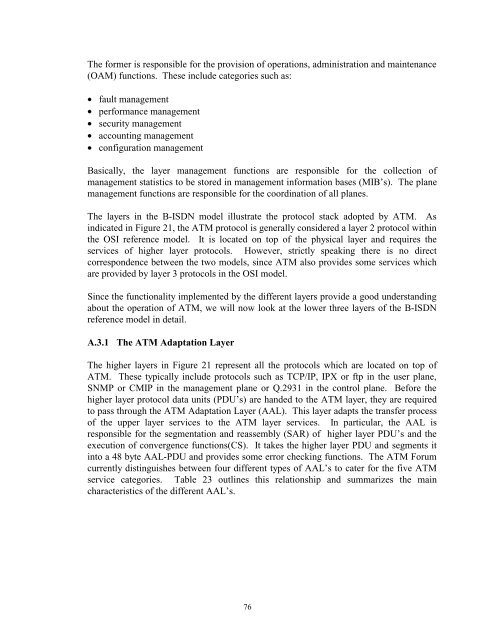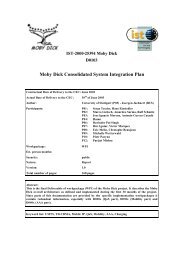COMNET III CACI
COMNET III CACI
COMNET III CACI
Create successful ePaper yourself
Turn your PDF publications into a flip-book with our unique Google optimized e-Paper software.
The former is responsible for the provision of operations, administration and maintenance<br />
(OAM) functions. These include categories such as:<br />
• fault management<br />
• performance management<br />
• security management<br />
• accounting management<br />
• configuration management<br />
Basically, the layer management functions are responsible for the collection of<br />
management statistics to be stored in management information bases (MIB’s). The plane<br />
management functions are responsible for the coordination of all planes.<br />
The layers in the B-ISDN model illustrate the protocol stack adopted by ATM. As<br />
indicated in Figure 21, the ATM protocol is generally considered a layer 2 protocol within<br />
the OSI reference model. It is located on top of the physical layer and requires the<br />
services of higher layer protocols. However, strictly speaking there is no direct<br />
correspondence between the two models, since ATM also provides some services which<br />
are provided by layer 3 protocols in the OSI model.<br />
Since the functionality implemented by the different layers provide a good understanding<br />
about the operation of ATM, we will now look at the lower three layers of the B-ISDN<br />
reference model in detail.<br />
A.3.1<br />
The ATM Adaptation Layer<br />
The higher layers in Figure 21 represent all the protocols which are located on top of<br />
ATM. These typically include protocols such as TCP/IP, IPX or ftp in the user plane,<br />
SNMP or CMIP in the management plane or Q.2931 in the control plane. Before the<br />
higher layer protocol data units (PDU’s) are handed to the ATM layer, they are required<br />
to pass through the ATM Adaptation Layer (AAL). This layer adapts the transfer process<br />
of the upper layer services to the ATM layer services. In particular, the AAL is<br />
responsible for the segmentation and reassembly (SAR) of higher layer PDU’s and the<br />
execution of convergence functions(CS). It takes the higher layer PDU and segments it<br />
into a 48 byte AAL-PDU and provides some error checking functions. The ATM Forum<br />
currently distinguishes between four different types of AAL’s to cater for the five ATM<br />
service categories. Table 23 outlines this relationship and summarizes the main<br />
characteristics of the different AAL’s.<br />
76
















